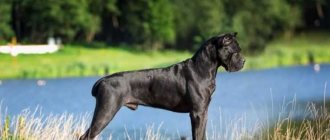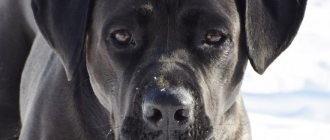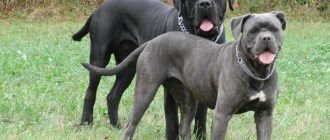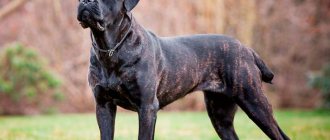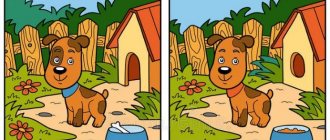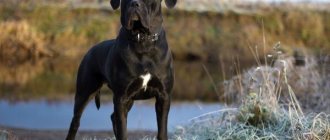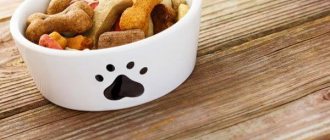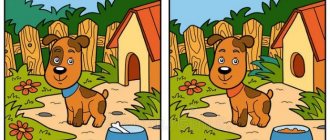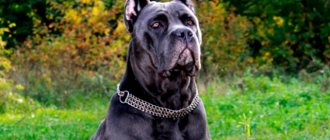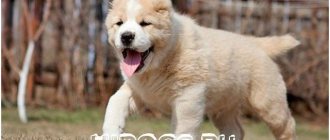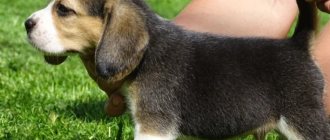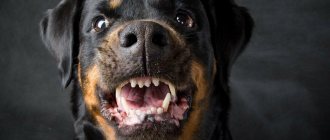Cane Corso are the oldest representatives of the Molossian dogs, descended from the ancient Roman gladiator fighting dogs. Today this breed is very popular all over the world, which is explained by their friendly nature, intelligence and easy care. Be that as it may, Cane Corso puppies, like representatives of other breeds, need competent care, care and education.
Breed card
- Known breed names: Italian Cane Corso, Italian Cane Corso, Cane Corso
- FCI breed number: 343
- Description of the standard on the FCI website: link
- Height at the withers: males - up to 68 cm, females - up to 64 cm
- Weight of an adult dog: males - up to 50 kg, females - up to 45 kg
- Color options: lead, black, fawn, light grey, red fawn, brindle.
- Life expectancy: 9-11 years<
- Puppy cost: from 15,000 to 90,000 rubles
- Size: 4 out of 5
- Learning ability: 3 out of 5
- Attitude towards children: 5 out of 5
- Shedding intensity: 3 out of 5
- Protective and guard qualities: 5 out of 5
How many times a day should you feed your Cane Corso?
Given the intensity of the animal’s growth, the puppy will have to be fed 5-6 times a day for up to 5 months. Then gradually reduce the number of meals: 5-6 months – 4-5 feedings; 6-8 months – 3-4 feedings; 8-10 months – 3 feedings. From 10 months the dog is ready to switch to 2 meals a day.
The Cane Corso Italiano is a dog with watchdog qualities, a serious appearance and a strong body. But in order for your pet to remain active and have excellent appearance, you need to feed it properly.
Characteristic
The Cane Corso is a medium to large sized dog, densely built, with developed lean muscles and loose skin. By nature, she is a guard - she protects the owner’s household property, keeps order in the family.
Breed standard FCI No. 343
According to the standard, the Cane Corso is a molossoid dog of the mastiff type. She has a large head with typical Molossian features - a wide skull, a square muzzle, with well-defined stops and brow ridges.
The short muzzle is harmoniously completed by a black nose with large nostrils. The bridge of the nose is without a hump, but does not bend down either. In the dog's mouth there are large curved jaws that close with a small bite. The lips hang over the lower jaw.
Slightly convex oval eyes, covered with thick eyelids, look with a wise and attentive expression. It seems that the dog understands the whole essence of the universe. The triangular ears are set wide apart on the head, with the tips hanging down.
The dog's body is slightly longer than the withers, it is built firmly, but does not form a square. The level of the withers rises above the wide and slightly sloping croup. Well developed chest reaches down to the level of the elbows. The Cane Corso's tail is set high, but does not curl. The Corsican dog walks widely, preferring to trot.
Obvious breed disadvantages:
- overly developed cheekbones;
- ring tail;
- depigmentation of the lobe;
- dewclaws;
- overshot from 5 mm.
A dog showing any obvious deviation from the standard will be disqualified from any show.
Cane Corso: all about the dog, photo, description of the breed, character, price
Dimensions, weight and height of the breed
The silhouette of the Cane Corso is rectangular, the body length is 11% greater than the height. The height of males is large - 64-68 cm, females - a little less - 60-64 cm. The standard allows for a discrepancy in size of a maximum of 2 centimeters, plus or minus. Adult male dogs weigh the same as a girl of average build - up to 50 kg. The weight of bitches is from 40 to 45 kg.
Possible colors
The Cane Corso's short, close-fitting coat comes in a variety of colors, from fawn sand to red fawn.
Other coat color variations:
- lead;
- grey;
- black;
- dark fawn;
- brindle.
A white spot on the chest or nose is allowed.
Puppy weight by month
A newborn Cane Corso puppy weighs 300-700 g. By two months he is growing up. The optimal weight at this time is 6-8 kg.
Full compliance with the age and weight of the puppies:
- 3 months – 14 kg;
- 6 months – 28 kg;
- 8 months – 36 kg;
- 10 months – 40-42 kg;
- 12 months – 44 kg.
At one year of age, these dogs are not aware of their enormous size and continue to behave like puppies.
Lifespan
Cane Corsos live about 9-11 years. During this time, the dog turns into a devoted pet and assistant for its owner. If you are not ready to lose your pet prematurely, provide him with decent care.
Allergenicity
The Cane Corso's coat is close-lying and short, and the dog is considered hypoallergenic. However, if you suffer from allergies, get tested before purchasing a puppy.
Cane Corso (Italian) photo of the dog, description of the breed
Memory period (4-7 weeks)
During this period, the puppies are too sensitive, they develop conditioned reflexes, which means that the puppies are quite ready for learning and training.
By the age of two months, the puppy’s weight should be from 6 to 8.5 kg. Incorrect and untimely adaptation can become a prerequisite for problems in the pet’s relationship with the outside world.
At this stage, it is worth observing the crumbs and determining the character of the future adult dog: who is the entertainer, the leader, and who is the impressive couch potato.
Weak kittens must be taken under guardianship; bullies are simply observed, distracted, and not punished.
In the future, he can grow into a champion, the pride of the owner. By forbidding a dog to communicate with other people, the owner makes a mistake. Subsequently, the puppy may become fearful or even aggressive.
It will become almost impossible to change your behavior. Suspiciousness and distrust are unacceptable traits for a domestic dog.
History of the breed
The first mentions of Molossian-type fighting dogs date back to ancient times in Rome. Italian cynologists believe that it is the Cane Corso breed that is of particular value among all Molossians. The dogs, incredibly similar to modern Italians, were used in gladiatorial combat and hunting.
The first written mentions of the breed date back to 1238. Historians have found the coat of arms of the aristocratic de Corsi family, which depicts a dog resembling a modern canoe. There is a theory according to which the name “Cane Corso” originated in Corsica. Another theory is that it comes from the Latin cohors, which translates to “to guard.”
Regardless of where the name came from, Corso working dogs were used in all walks of life - they guarded territories, helped in hunting, herded cows and pigs. An equally important task of the ancient Molossians was the protection of food convoys.
During World War II, the standard of living of the population dropped significantly, and the Cane Corso population declined sharply. Some individuals remained alive among farmers and shepherds in Italy. Through the efforts of fanatical breeders, the breed was revived from a pair of purebred representatives.
In 1984, the dog breed society adopted a breed standard drawn up by Antonio Morsiani. The Italian Kennel Club compiled a stud book, which included records of more than 500 representatives. By 1994, the Kennel Club officially recognized the standard. The Fédération Cynologique Internationale included the breed in its standards in 1996.
Cane Corso breed: where to buy
Nowadays, purchasing a purebred puppy of this breed is very problematic. In addition, choosing a puppy is a problem that can only be handled by a professional. Under no circumstances should you rely on your basic knowledge or simply on the recommendations of breeders.
It is very good if kennels that practice breeding dogs of a famous breed use imported producers related to the ancestors of real Cane Corsos. This will be proof that they sell dogs with typical behavior, high performance, strong bones and graceful movements. Parents of puppies must pass all tests and be verified by producers who are not prone to dysplasia.
What to pay attention to
When choosing a Cane Corso puppy, you should pay special attention to such factors as:
- The parents of the puppy have all the documents indicating that they have passed all tests for the presence of elbow and hip dysplasia, with an official conclusion from an RKF specialist.
- The parents have all tests related to the absence of mental defects, which must be certified in a separate document.
- A parent pair participating in breeding work must have a “very good” rating obtained at a breeding show.
As a rule, babies from multiple litters are larger in size, and they are stronger and more well-fed. Despite this, puppies must be absolutely healthy, active and playful, have an excellent appetite, show curiosity and not be cowardly. Nowadays, it is more common to sell animals that solely in appearance resemble breed standards.
These pets may develop various negative behavioral problems over time. This could be either a defect in the work of the breeders, or problems with raising the animal, which is more likely, since not all owners bother themselves with the problems of raising and socializing the animal.
All puppies offered must have all vaccinations and ears and tail docked. Babies can easily be determined whether they correspond to the breed type by their good anatomical structure, as well as by their clean and calm look. Such individuals are practically socialized and have a stable and strong psyche. All that remains is to properly raise the animal in the family, in a calm environment. Accompanying documents must indicate that the puppies have all vaccinations. The owner must have documents such as birth certificates, veterinary passports and a standard purchase and sale document in his hands.
Cost of Cane Corso puppies
It is quite natural that puppies whose pedigree includes producers of the most famous world-famous kennels, such as “Della Porta Dipinta”, “Del Rosso Malpelo”, “Cane Per La Vista” and “Best Griffs Off Destiem”, are the most expensive. The most expensive puppies, and therefore the most promising, quite often become titled, both abroad and in our country.
As a rule, the cost of a purebred puppy starts from 1 thousand dollars and no lower. At the same time, individuals with rare coat colors are much more expensive.
Character
The Cane Corso breed is prestigious and gaining popularity. The dog can be kept in an apartment or a private house - thanks to its medium size, it will take root well in any conditions. The only restriction that the canoe cannot tolerate is the chain. Left to guard the house, being tied to the booth. The dog will experience a lack of communication. In winter, the dog should be kept in a warm house.
All representatives of the breed have highly developed guard qualities. He protects everything that he considers his - family members, property, land. Constantly monitors the situation around him. Suspecting a guest of bad intentions, the Corso will let others know this. He will not be the first to attack; he will act only in response to aggression or on the orders of the owner.
He treats other pets with interest and friendliness if they do not encroach on his personal space.
Intelligent and unobtrusive, but enjoys playing outdoor games. Needs communication and a feeling of “usefulness”. Doesn't bark in vain - only gives voice in exceptional cases.
Cane Corso dog breed: characteristics, photos, character
Puppy in the first month
Newborn babies are still very tiny. They are born weighing 300–700 g. In the first 2 weeks, the puppy has only physiological needs: eating, sleeping. Now he is completely dependent on his mother.
On the 12th day, the baby’s eyes open, but his vision is still very poor. By the end of the second week, the puppy develops hearing - this is manifested by the fact that he already reacts to sharp sounds. The baby is already standing steadily on his paws.
When a Corso is just born, all he cares about is sleeping and eating. The only thing the owner needs to monitor is that he does not remain hungry, as well as the puppy’s weight. The baby should recover steadily.
Even if he was born well-fed, this does not mean that he is the strongest and healthiest. If he then gains weight poorly, this is a warning sign. Such a puppy is either malnourished (then the owner’s help in feeding is needed) or is sick. In any case, over time he will begin to lag behind in development.
The weight of a newborn can range from 300 to 700 grams. It depends on the number of brothers and sisters: the more puppies, the more “compact” they are.
After 12 days, babies should fully open their eyes. They still see poorly, and move mainly around each other and up to their mother. They will begin to hear only at the age of three weeks. This can be noticed by observing how puppies begin to react to sounds, especially sharp and loud ones. But they already see well, stand confidently on their feet and can eat soft, porridge-like food themselves.
You may be surprised, but from a month you can already start raising your baby - he is just forming conditioned reflexes. You just need to communicate with him carefully, since now he is the most vulnerable. If the puppy is weaker than other peers, protect him. If he is aggressive, besiege him, but gently.
Learning ability
The Cane Corso is a stubborn and cunning dog. During training, she tries with all her might to ignore her owner’s commands, especially in puppyhood.
A beginner needs to make an appointment with a professional dog handler - it is impossible to achieve obedience on your own without experience.
If you show persistence and methodically repeat commands on every walk and ensure their implementation, training a Cane Corso will not be difficult - it will master the general training course and protective service.
Start raising a puppy by establishing clear rules of behavior in the apartment. If the puppy does unwanted actions - climbs on the bed or chews slippers - scold him. Encourage positive moments. A smart Corso will quickly understand what they want from him.
From 4 to 8 months – the period of the “escape” instinct
Dogs that are not properly socialized during this period often become unpredictable, fearful, or aggressive. It is during this time that the dog should gain positive experience interacting with new places, things and various objects.
Starting at 7 weeks, the puppy will begin to:
- transfer attention from the mother to his surroundings
- show individual traits
- any painful or frightening experience can have a lasting effect
During this period, the puppy needs:
- getting to know new objects, places and people
- positive nature of impressions (encouragement, praise, treats and treats)
- a comfortable place where the puppy will feel safe
- supervision of the litter and protection from overly active or strong puppies
- gradual adaptation to frightening situations, such as a car or a vacuum cleaner (don't push the puppy, let him get used to it and adapt to the situation)
During these few weeks, the puppy should see you as the main leader. Now the main focus and center of attention of your pet should be only you.
During these few weeks, the puppy will watch you and your family very closely. It selects appropriate human reactions and behavior. He also begins to study the hierarchy in his pack (family) and will try to figure out where he stands in this hierarchy. This is precisely what is associated with the sudden change in behavior of such a small and cute puppy.
The puppy will begin:
- question all authority
- try to dominate
- grab the leash
- growl periodically
If your puppy becomes agitated, aggressive, or growls, you should stop all activities with him. Also, do not leave children unattended with the puppy and try to enroll the puppy in training courses. Make sure that all family members understand the puppy's transition period and that your actions are coordinated - use a “united front strategy.”
During this period, the puppy will decide that he is ready to live alone, so you should show him that he must stay close and come when his name is called.
We suggest you read: What do crows eat in urban environments?
What will happen:
- the puppy will become more independent
- he will go very far, often into risky situations
- the puppy will start running away from you
During this time in an unfenced area, you should keep the young dog on a leash at all times. Continue teaching basic commands and reinforce correct behavior with praise and treats. Use only positive teaching methods.
Your energetic and rambunctious puppy will suddenly become afraid of even the usual sounds of a car or music. You may find that he suddenly refuses to take the usual stairs or gets shaken when riding in a car.
A puppy who was recently very confident will suddenly become resistant to new things. However, you should avoid extremes and be calm and consistent. Be patient and use positive methods such as praise and treats when your puppy makes even unsuccessful attempts.
Attitude towards children
The Cane Corso treats children with care, with a share of “parental” attention. He will never offend the weak and will tolerate even inaccurate advances from strangers. If the Corso gets tired of children's attention, he will try to leave, and if he cannot, he will courageously endure manifestations of love.
Unlike other large dogs, the cane is well aware of its size and behaves carefully with children. It will not crush even the smallest ones with its own weight. The worst punishment for a sensitive cane is the childish tears of a child under his care.
Industrial or natural food?
Perhaps you have already become a participant in the debate about which method of feeding is better, healthier, more natural. A reasonable person is unlikely to take a one-sided position, since both industrial and natural food are suitable for keeping a dog; the question is their quality and the method of feeding.
Below we will briefly discuss the main points:
- The Cane Corso is considered one of the most expensive dogs to own. Everything is quite simple, a tendency to allergies obliges the owner to buy hypoallergenic dry food for Cane Corso for life, and this is a considerable expense.
- Natural food is considered more natural to digest and there is some truth in this.
- Premium quality industrial food (selected according to the age, weight and breed of the dog) contains a full range of vitamins and microelements, which greatly simplifies the preparation of the diet. Basically, you just need to follow the instructions.
- If you are worried that your dog will get tired of eating only dry food, you can alternatively dilute the diet with semi-moist food of the same brand.
- Preparing a natural diet will require regular adjustments, depending on the season of the year and the condition of the pet. In addition, do not forget that even the highest quality products will not provide the four-legged animal with the necessary amount of vitamins and microelements.
Note!
One of the main advantages of dry food is its long shelf life. You can be sure that you can feed your dog while traveling or leave dinner in the automatic feeder in case there is a chance that you will be late from work.
Whatever feeding method you choose, it is worth remembering that a dog is not a person and does not need a riot of tastes and variety. It is strictly not recommended to mix industrial and natural food, otherwise you will deliberately harm the digestive system of your ward. If you feed your dog dry food, then the treats should be industrial; in the case of “natural food”, you can use your favorite foods or pieces of dried meat as “goodies”.
Protective and guard qualities
The dog is tolerant of the owner's guests if they are not aggressive. But if he finds a stranger on the territory, he will not let him leave. At the first opportunity, Corso will fearlessly grab him and crush him with steel muscles and a death grip. At such moments, it is impossible to appease the dog with a treat or distract it with a toy.
For its size, the dog is surprisingly agile, dexterous and capable of overcoming difficult obstacles in pursuit of a criminal.
Cane Corso: photo, character, puppies, standards, all about the breed
Feeding Cane Corso dry food
The dog needs to choose the highest quality dry food that is most suitable for its health condition and age. An active adult Cane Corso needs approximately 700-800 grams of pellets per day. You can calculate the food depending on the weight of the animal: 20-40 grams per 1 kg of dog’s body weight.
For dogs that are used for service work, the rate should be slightly higher. Although in any case you need to carefully study the instructions of the food manufacturer. When switching a dog to a new food, for the first two months you need to carefully monitor its physical form.
Overfeeding with high-calorie foods can lead not only to the acquisition of very serious diseases: musculoskeletal disorders and diabetes. For old and inactive dogs due to illness, lighter food is selected and the daily portion is divided into two or three times.
When it comes to properly raising a large breed dog, the first and most basic factor for success is maintaining and strengthening the joints. Since the first 3 years of life are actively growing bones and gaining muscle mass, it is important to maintain a strict balance. Proper feeding of the Cane Corso, like any other dog, implies a balanced supply of proteins, fats, carbohydrates, vitamins and microelements. In theory, everything looks quite simple, but in practice, owners often make mistakes in preparing their pets’ diet.
Before buying a puppy, and even more so planning a diet for a Cane Corso, it is worth understanding all the intricacies concerning the metabolic processes of this breed. To begin with, we note that among these giants there are often allergy sufferers, and this is a rather complex problem. If we look at the issue globally, we can name two types of allergies - food or to any other substances from the environment. Acute reactions to food can be avoided in two ways:
- Determine the allergen by exclusion and remove it from the diet.
- Switch your dog to hypoallergenic food.
The second extremely important issue is controlling the dog’s weight. Even in puppyhood, excess fat can have an extremely negative impact on the condition of the dog’s joints. There is a set of rules that will help control your pet’s weight at any age:
- Feed the Cane Corso strictly following the daily allowance. You can divide the food into 2-3 meals, but you should not overfeed your dog.
- The amount of carbohydrates should be compared with physical activity. If you are forced to reduce your exercise, then the calorie content of your diet needs to be reduced.
- When kept on a commercial diet, the pet may ask for supplements. The specificity of food granules is such that they gain volume after entering the stomach, that is, the pet does not immediately feel full. If your heart cannot stand the pleading eyes, it is better to give your pet a bone made from dried tendons, but again, do not overfeed. In the case of a natural diet, the pet can eat moslak or soft cartilage.
- Weigh your four-legged animal regularly. This elementary procedure allows you to fully control not only proper development, but also the rate of weight gain.
Content
The excellent health of the Cane Corso allows him to get along well in the city and in a private home. The owner needs to monitor the condition of the dog's eyes and ears and clean them regularly.
Need for physical activity
The owner's key responsibility towards the dog is to keep it healthy. Walk your Corso every day for 2 hours a day. To keep your dog entertained while walking, engage in training. Learn the commands “fetch” and “come to me”, and then include more complex exercises. Buy balls and throw them during walks to keep your pet in physical shape.
Walk pregnant Corso bitches three times a day, without giving excessive stress. Nursing mothers will have to be walked 4-5 times a day for 15 minutes.
Appearance care
The Cane Corso's coat, although short, requires care. To maintain shine, clean the hide with a brush and wipe with a sponge. Before brushing, massage your dog with light hand movements against the fur to identify particularly dirty areas. Start the procedure from the back, smoothly moving towards the limbs.
Clean your ears and eyes twice a week with a cotton pad soaked in lotion from the veterinarian.
Nutrition
The Cane Corso's diet is no different from that of other dog breeds. Feed your pet dry kibble or natural foods. Natural food is cheaper, but preparation is time-consuming. Also, to maintain your dog’s health, you will have to maintain a balance of proteins, carbohydrates, vitamins and fats in the food.
Ready-made food is much more expensive, but it saves time on selecting and combining ingredients.
Puppy in the first month
This is the ideal period to wean your baby from his mother. He can now fully feed himself. His diet should include meat, vegetables, cereals and dairy products.
At 2–3 months old, puppies are very inquisitive. They enjoy exploring the world around them, play a lot and have fun. During this period, they need love and affection more than ever.
As a rule, the first mating is carried out during this period. After it, the males again try to take leadership positions, but this time not within the family circle, but among other dogs. Thanks to their strength, Cane Corsos can cause great harm to other pets with whom they previously played during a walk. Under no circumstances should a dog be allowed to assert itself in this way.
The dog’s character can be adjusted up to three years of age, but the older he gets, the more difficult it is to do this.
Typical diseases of this breed
Cane Corsos rarely get sick, but you should not neglect the prevention of common “canine” diseases.
Known Cane Corso diseases:
- distemper – for prevention, vaccinate your dog regularly;
- leishmaniasis;
- joint dysplasia;
- turning of the eyelids.
Cane Corso puppies: description, photo, price, selection criteria
Main stages of development
From this video you will learn about the character of a Cane Corso dog and how to care for a dog.
from 3 to 8 weeks – a period of rapid growth
During this period, Corso puppies undergo primary socialization. They leave the nest on their own and explore the world around them. The lessons learned at this stage are critical.
Puppies that have been weaned too early tend to be more nervous and bark and bite more often. Often this happens only because these lessons that the puppy should have learned from the mother and from her litter were missed. Problems with training and further socialization can also often be attributed to puppies that are separated from the litter too early.
Starting at 3 weeks of age, puppies learn:
- basic dog behavior patterns
- the meaning of a bite and what it feels like to be bitten
- the meanings of various positions and their effect on the mother and litter
- the meaning of barking and other sounds
- how to establish relationships and interact with other dogs
After 5 weeks, puppies begin to understand:
- the need to obey the leader of the pack
- complex behavior patterns, as well as the meaning of most sounds and postures
The mother of the puppies will growl and grab her puppies, thereby giving them clear signals about acceptable behavior. Soon after birth, a short glance or a subtle growl will be enough to control the mother's young puppy. The puppies in the litter will also learn to understand signals when communicating with each other.
Photo of a Cane Corso puppy at 4 weeks (1 month)
Photo of a Cane Corso puppy at 2 months
Photo of a Cane Corso puppy at 3 months
Photo of Cane Corso at 4 months
Photo of Cane Corso at 5 months
Photo of Cane Corso at 6 months
Photo of Cane Corso at 12 months (1 year)
Buying a puppy
The revived Cane Corso breed is relatively young, and today it is not easy to buy a purebred puppy of good blood. The cost varies from 15 to 90 thousand rubles depending on the class of the dog - breed, pet or show. The last one is the most expensive, exhibition one.
If you need a representative of the breed for participation in exhibitions and breeding, contact trusted breeders and do not save money. If you buy a cheap puppy, you risk getting a dog with congenital diseases or bad genetics.
Eight months to a year
During this period, the dog’s character is formed and he is ready for simple training. It is already clear who will have the makings of a leader. Depending on this, the method of training for a given period is selected. It is recommended to “push” inactive children to move, and to simply observe and make sure that active children do not harm themselves or spoil valuable things. Under no circumstances should you punish them, otherwise they will grow up fearful or aggressive.
We invite you to read: Day-old ducklings, what conditions do they need?
It is important that puppies can have contact with people, then they will treat them normally, and strangers in the house will not cause aggression or fear in the dog.
Like humans, puberty in dogs is a time of protest, disobedience, and self-display.
Now the puppy may refuse to follow commands, rebel against your demands, and sometimes growl. Sometimes the dog begins to be jealous of the chosen family member towards others, including children. During walks, he “goes crazy” and runs completely different from where you are leading him.
Surprisingly, at the same time he is very shy and sensitive. Sometimes it seems that he has become a two-month-old baby again, who has never seen other dogs or strangers in his life.
The owner will have a difficult time during this period, since he needs to find a balance between the rigidity necessary to suppress aggressive behavior and kindness so that the teenage Corso does not feel rejected. In a word, everything about him is like a person’s.
At 8 months, males should weigh 38-40 kg, females - 34-36 kg. By the year the weight will increase: 44-46 kg and 38-43 kg, respectively.
After a year, up to 3-4 years, the personality of the Cane Corso still continues to develop, as does the body. Some character traits may change, and if you give a male dog for mating, after that he, feeling like a macho, will again try to push the owner off his “pedestal”. As always, you need to be firm, but loving and patient. By the age of two, males weigh, according to the standard, 48-55 kg, females - 38-45 kg.
How is your Cane Corso baby developing? Tell us about it in the comments and don't forget to like.
Maintenance and care
The Corso is a working breed that requires a lot of exercise to maintain its shape. He will need at least a 20-minute brisk walk or jog every morning and evening. If you often ride a bike, then jogging next to you will be an excellent warm-up for your Corso.
The Corso is a breed that should not sit idle all day. Your pet can excel in a variety of tasks—livestock guarding, various farm jobs, obedience training, and most dog sports.
Don't let your Corso run freely without a leash. If you have a yard, then it should be fenced with a reliable and high fence. Crate training will also be of great benefit to him, which will guarantee the safety of your property and save your pet from many troubles when you are not around. A cage or pen can also be a great place to sleep.
Since the breed is quite large, be prepared to pay large bills for food and veterinary expenses. Neutering a larger dog is also more expensive than spaying smaller breeds. Costs for dog sitters, puppy classes and club fees will also be higher. It's important to consider all of these potential costs if you're considering getting a Corso, as you'll be incurring them for 10 to 12 years.
